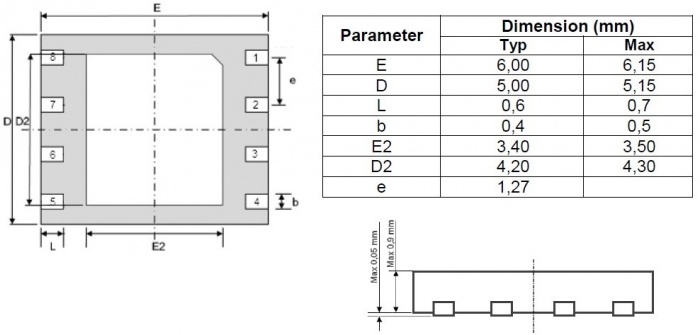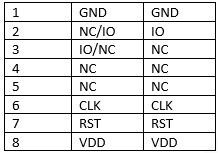Requirements for eSIM: Difference between revisions
No edit summary |
No edit summary |
||
| Line 31: | Line 31: | ||
| style="width: 150px; background: black; color: white;" rowspan=2 |'''Possibility to solder eSIM?''' | | style="width: 150px; background: black; color: white;" rowspan=2 |'''Possibility to solder eSIM?''' | ||
| style="width: 150px; background: black; color: white;" colspan=2 |'''Possibility to have eSIM + another SIM?''' | | style="width: 150px; background: black; color: white;" colspan=2 |'''Possibility to have eSIM + another SIM?''' | ||
|+ | |+ | ||
| style="width: 150px;" rowspan=2 |'''FMB100/FMB110/FMB120/FMB130''' | | style="width: 150px;" rowspan=2 |'''FMB100/FMB110/FMB120/FMB130''' | ||
| Line 72: | Line 67: | ||
| style="width: 150px;" colspan=2 |'''No''' | | style="width: 150px;" colspan=2 |'''No''' | ||
|+ | |+ | ||
| style="width: 150px;" rowspan=2 |'''FMB202/FMB204/FMB206 | | style="width: 150px;" rowspan=2 |'''FMB202/FMB204/FMB206''' | ||
| style="width: 150px;" rowspan=2 |'''uSIM''' | | style="width: 150px;" rowspan=2 |'''uSIM''' | ||
| style="width: 150px;" rowspan=2 |'''Yes''' | | style="width: 150px;" rowspan=2 |'''Yes''' | ||
| Line 141: | Line 136: | ||
| style="width: 150px;" rowspan=2 |'''Yes''' | | style="width: 150px;" rowspan=2 |'''Yes''' | ||
| style="width: 150px;" rowspan=2 |'''Yes. 2 x eSIM Possible''' | | style="width: 150px;" rowspan=2 |'''Yes. 2 x eSIM Possible''' | ||
|+ | |+ | ||
| style="width: 150px;" rowspan=2 |'''FMP100''' | | style="width: 150px;" rowspan=2 |'''FMP100''' | ||
Revision as of 07:15, 1 October 2019
Main Page > Frequently Asked Questions - FAQ > Requirements for eSIMAn embedded-SIM (eSIM) or embedded universal integrated circuit card (eUICC) is a form of programmable SIM card that is embedded directly into a device. The surface mount format provides the same electrical interface as the full size, 2FF and 3FF SIM cards, but is soldered to a circuit board as part of the manufacturing process. In machine to machine (M2M) applications where there is no requirement to change the SIM card, this avoids the requirement for a connector, improving reliability and security. An eSIM can be provisioned remotely; end-users can add or remove operators without the need to physically swap a SIM from the device.
In order to use eSIM with Teltonika FM devices some basic requirements must be met.
1. eSIM dimensions
Must match standard MFF2 eSIM size:

2. eSIM pin-out
There are two default eSIM pin-outs:

The only difference in pin-outs is the IO pin – 2 or 3. Both versions of pin-outs are suitable for devices with eSIM.
3. Requirements for eSIM packing reel:
13“ in diameter.
4. Compatibility with Teltonika FM devices
| Project | Current SIM configuration | Possibility to solder eSIM? | Possibility to have eSIM + another SIM? | |
| FMB100/FMB110/FMB120/FMB130 | uSIM | Yes | Yes. uSIM + eSIM | |
| FMB140 | uSIM | Yes | Yes. uSIM + eSIM | |
| FMU120/FMC120/FMM120 | uSIM | Yes | No | |
| FMU122/FMC122/FMM122 | Dual SIM | Yes | No | |
| FMU125/FMC125/FMM125 | Dual SIM | Yes | No | |
| FMU126 | Dual SIM | Yes | No | |
| FMU130/FMC130/FMM130 | uSIM | Yes | No | |
| FMB202/FMB204/FMB206 | uSIM | Yes | Yes. uSIM + eSIM | |
| FMB207/FMB208 | uSIM | Yes | Yes. uSIM + eSIM | |
| FMB900/FMB920 | uSIM | Yes | Yes. uSIM + eSIM | |
| MTB100 | uSIM | Yes | No | |
| FMB964/FMB962 | uSIM | Yes | Yes. uSIM + eSIM | |
| FMC640/FMM640 | Dual SIM | Yes | Yes. 2 x eSIM Possible | |
| FMB640 | Dual SIM | Yes | Yes. uSIM + eSIM | |
| FMB001/FMB010 | uSIM | Yes | Yes. uSIM + eSIM | |
| FMB002/FMB020/FMB003 | nano-SIM | No | - | |
| FMM001/FMC001 | uSIM | Yes | No | |
| FM3001 | uSIM | Yes | No | |
| FM36M1 | SIM | Yes | No | |
| FM3612 | SIM | Yes | No | |
| FM6300 | Dual SIM | Yes | Yes. 2 x eSIM Possible | |
| FMP100 | eSIM | - | - | |
